Human Resources Management
VerifiedAdded on 2023/01/06
|11
|3396
|43
AI Summary
This document explores the impact of culture on managerial decision making in the field of human resources management. It discusses the influence of culture on organizational performance, the management of people, and the challenges faced in overseeing individuals. The paper also examines the impact of culture on the strategic choices of HRM and the management of global managers.
Contribute Materials
Your contribution can guide someone’s learning journey. Share your
documents today.
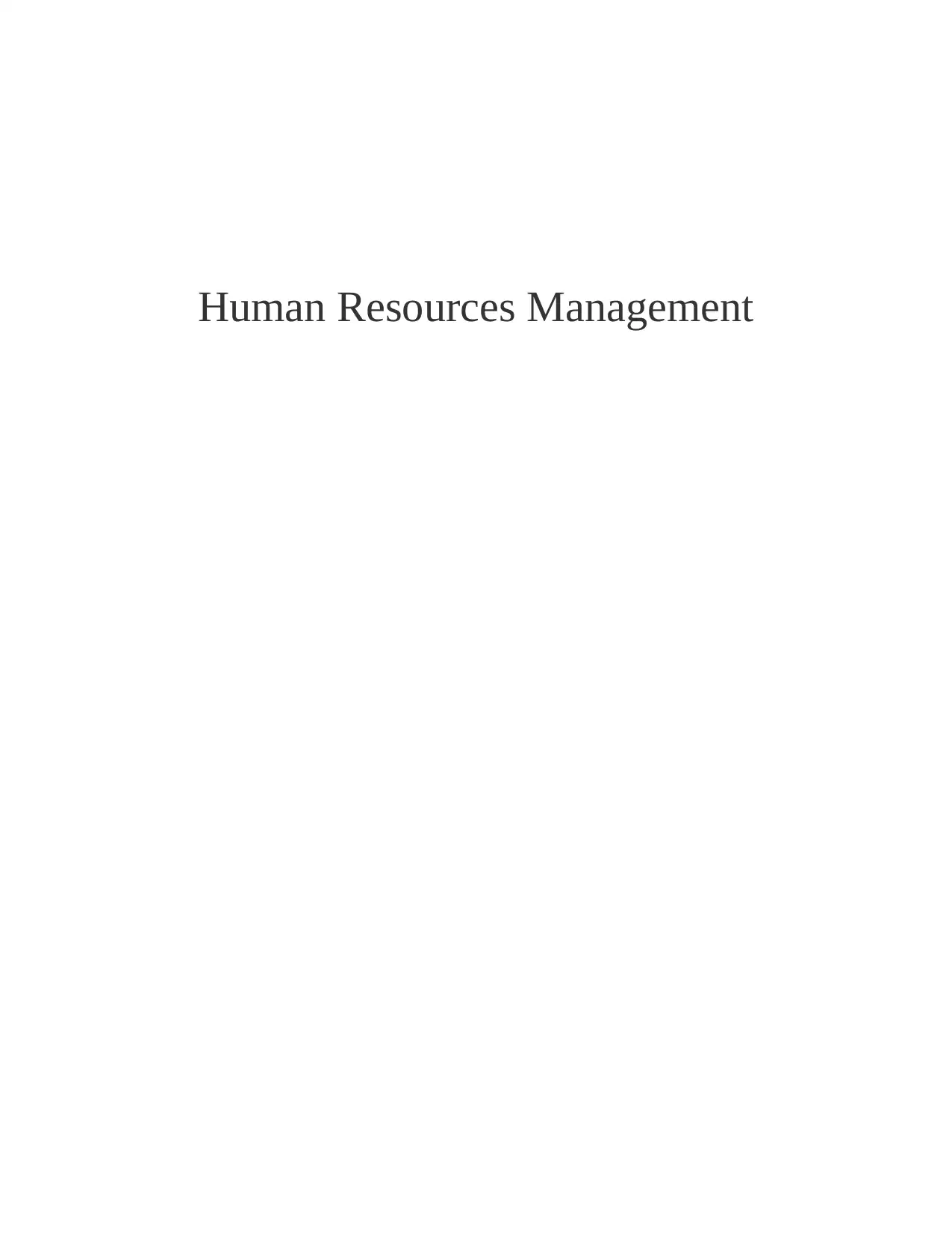
Human Resources Management
Secure Best Marks with AI Grader
Need help grading? Try our AI Grader for instant feedback on your assignments.
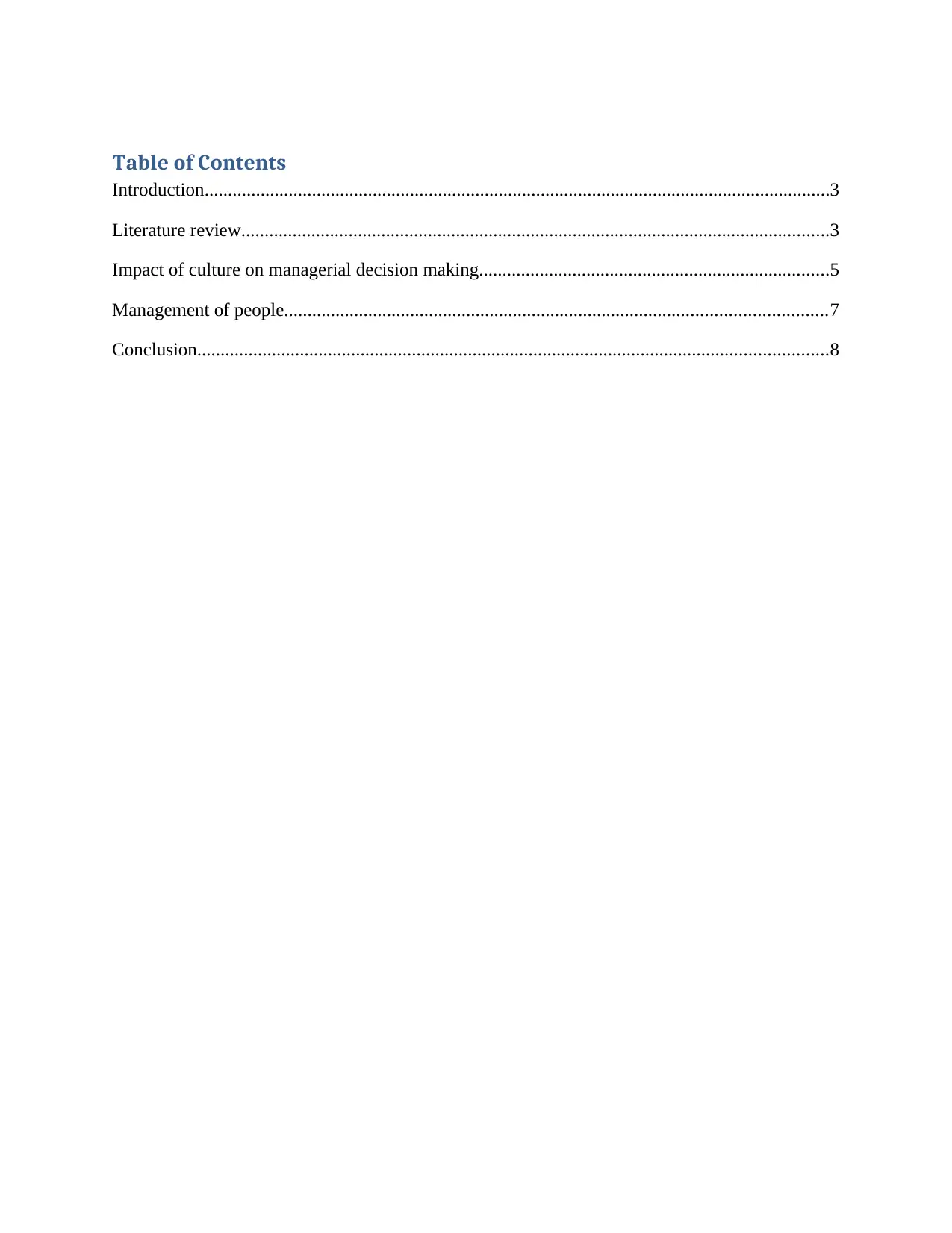
Table of Contents
Introduction......................................................................................................................................3
Literature review..............................................................................................................................3
Impact of culture on managerial decision making...........................................................................5
Management of people....................................................................................................................7
Conclusion.......................................................................................................................................8
Introduction......................................................................................................................................3
Literature review..............................................................................................................................3
Impact of culture on managerial decision making...........................................................................5
Management of people....................................................................................................................7
Conclusion.......................................................................................................................................8
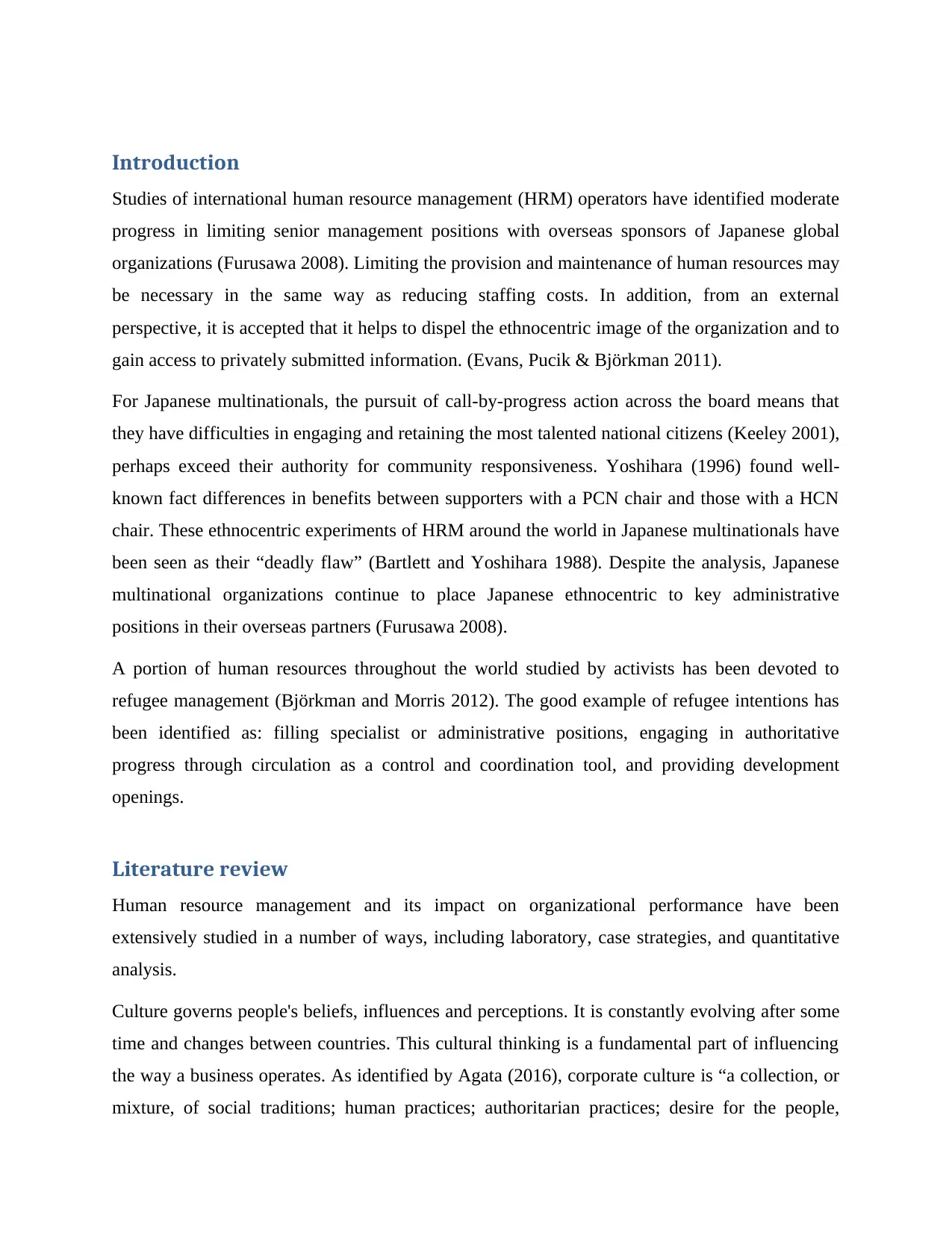
Introduction
Studies of international human resource management (HRM) operators have identified moderate
progress in limiting senior management positions with overseas sponsors of Japanese global
organizations (Furusawa 2008). Limiting the provision and maintenance of human resources may
be necessary in the same way as reducing staffing costs. In addition, from an external
perspective, it is accepted that it helps to dispel the ethnocentric image of the organization and to
gain access to privately submitted information. (Evans, Pucik & Björkman 2011).
For Japanese multinationals, the pursuit of call-by-progress action across the board means that
they have difficulties in engaging and retaining the most talented national citizens (Keeley 2001),
perhaps exceed their authority for community responsiveness. Yoshihara (1996) found well-
known fact differences in benefits between supporters with a PCN chair and those with a HCN
chair. These ethnocentric experiments of HRM around the world in Japanese multinationals have
been seen as their “deadly flaw” (Bartlett and Yoshihara 1988). Despite the analysis, Japanese
multinational organizations continue to place Japanese ethnocentric to key administrative
positions in their overseas partners (Furusawa 2008).
A portion of human resources throughout the world studied by activists has been devoted to
refugee management (Björkman and Morris 2012). The good example of refugee intentions has
been identified as: filling specialist or administrative positions, engaging in authoritative
progress through circulation as a control and coordination tool, and providing development
openings.
Literature review
Human resource management and its impact on organizational performance have been
extensively studied in a number of ways, including laboratory, case strategies, and quantitative
analysis.
Culture governs people's beliefs, influences and perceptions. It is constantly evolving after some
time and changes between countries. This cultural thinking is a fundamental part of influencing
the way a business operates. As identified by Agata (2016), corporate culture is “a collection, or
mixture, of social traditions; human practices; authoritarian practices; desire for the people,
Studies of international human resource management (HRM) operators have identified moderate
progress in limiting senior management positions with overseas sponsors of Japanese global
organizations (Furusawa 2008). Limiting the provision and maintenance of human resources may
be necessary in the same way as reducing staffing costs. In addition, from an external
perspective, it is accepted that it helps to dispel the ethnocentric image of the organization and to
gain access to privately submitted information. (Evans, Pucik & Björkman 2011).
For Japanese multinationals, the pursuit of call-by-progress action across the board means that
they have difficulties in engaging and retaining the most talented national citizens (Keeley 2001),
perhaps exceed their authority for community responsiveness. Yoshihara (1996) found well-
known fact differences in benefits between supporters with a PCN chair and those with a HCN
chair. These ethnocentric experiments of HRM around the world in Japanese multinationals have
been seen as their “deadly flaw” (Bartlett and Yoshihara 1988). Despite the analysis, Japanese
multinational organizations continue to place Japanese ethnocentric to key administrative
positions in their overseas partners (Furusawa 2008).
A portion of human resources throughout the world studied by activists has been devoted to
refugee management (Björkman and Morris 2012). The good example of refugee intentions has
been identified as: filling specialist or administrative positions, engaging in authoritative
progress through circulation as a control and coordination tool, and providing development
openings.
Literature review
Human resource management and its impact on organizational performance have been
extensively studied in a number of ways, including laboratory, case strategies, and quantitative
analysis.
Culture governs people's beliefs, influences and perceptions. It is constantly evolving after some
time and changes between countries. This cultural thinking is a fundamental part of influencing
the way a business operates. As identified by Agata (2016), corporate culture is “a collection, or
mixture, of social traditions; human practices; authoritarian practices; desire for the people,
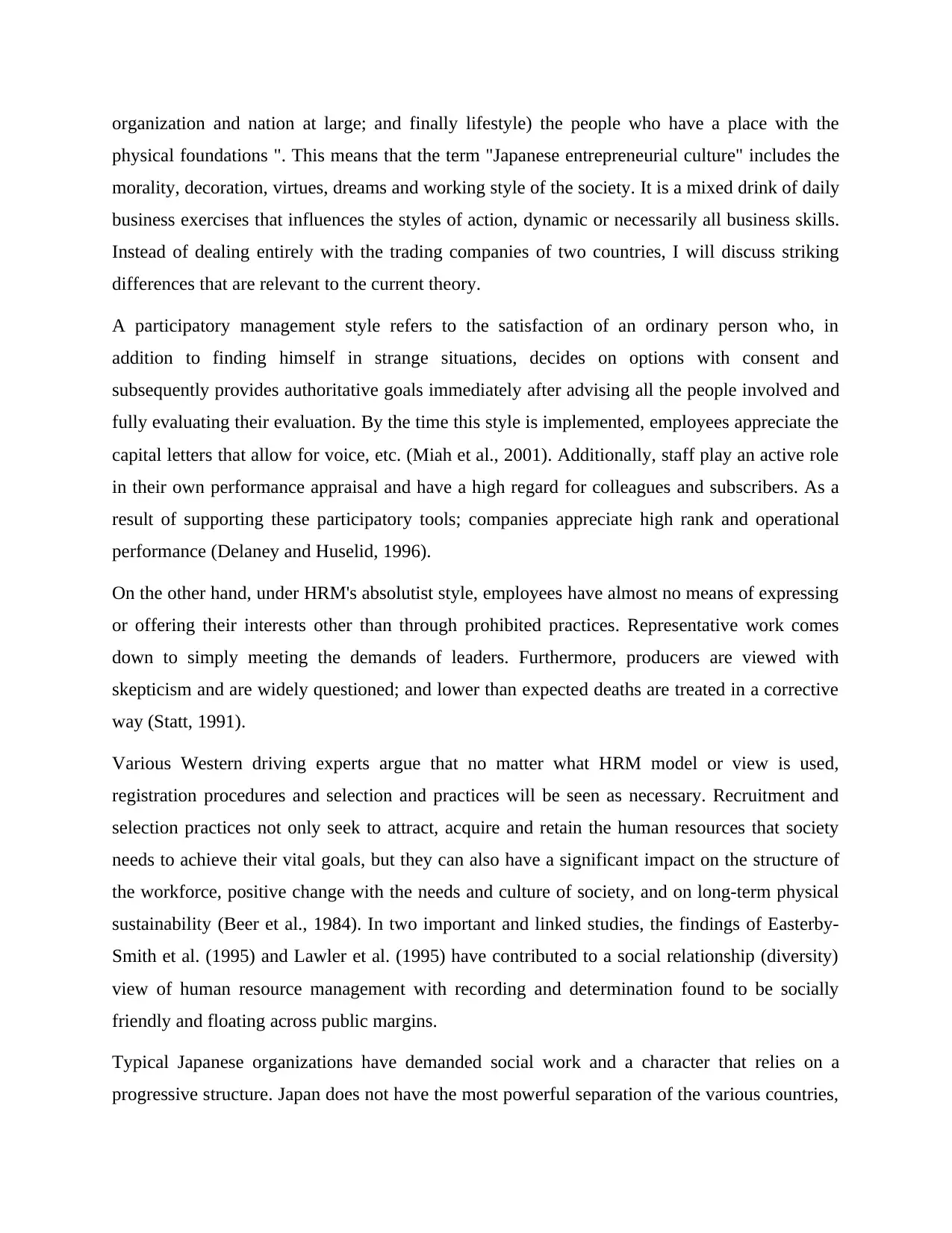
organization and nation at large; and finally lifestyle) the people who have a place with the
physical foundations ". This means that the term "Japanese entrepreneurial culture" includes the
morality, decoration, virtues, dreams and working style of the society. It is a mixed drink of daily
business exercises that influences the styles of action, dynamic or necessarily all business skills.
Instead of dealing entirely with the trading companies of two countries, I will discuss striking
differences that are relevant to the current theory.
A participatory management style refers to the satisfaction of an ordinary person who, in
addition to finding himself in strange situations, decides on options with consent and
subsequently provides authoritative goals immediately after advising all the people involved and
fully evaluating their evaluation. By the time this style is implemented, employees appreciate the
capital letters that allow for voice, etc. (Miah et al., 2001). Additionally, staff play an active role
in their own performance appraisal and have a high regard for colleagues and subscribers. As a
result of supporting these participatory tools; companies appreciate high rank and operational
performance (Delaney and Huselid, 1996).
On the other hand, under HRM's absolutist style, employees have almost no means of expressing
or offering their interests other than through prohibited practices. Representative work comes
down to simply meeting the demands of leaders. Furthermore, producers are viewed with
skepticism and are widely questioned; and lower than expected deaths are treated in a corrective
way (Statt, 1991).
Various Western driving experts argue that no matter what HRM model or view is used,
registration procedures and selection and practices will be seen as necessary. Recruitment and
selection practices not only seek to attract, acquire and retain the human resources that society
needs to achieve their vital goals, but they can also have a significant impact on the structure of
the workforce, positive change with the needs and culture of society, and on long-term physical
sustainability (Beer et al., 1984). In two important and linked studies, the findings of Easterby-
Smith et al. (1995) and Lawler et al. (1995) have contributed to a social relationship (diversity)
view of human resource management with recording and determination found to be socially
friendly and floating across public margins.
Typical Japanese organizations have demanded social work and a character that relies on a
progressive structure. Japan does not have the most powerful separation of the various countries,
physical foundations ". This means that the term "Japanese entrepreneurial culture" includes the
morality, decoration, virtues, dreams and working style of the society. It is a mixed drink of daily
business exercises that influences the styles of action, dynamic or necessarily all business skills.
Instead of dealing entirely with the trading companies of two countries, I will discuss striking
differences that are relevant to the current theory.
A participatory management style refers to the satisfaction of an ordinary person who, in
addition to finding himself in strange situations, decides on options with consent and
subsequently provides authoritative goals immediately after advising all the people involved and
fully evaluating their evaluation. By the time this style is implemented, employees appreciate the
capital letters that allow for voice, etc. (Miah et al., 2001). Additionally, staff play an active role
in their own performance appraisal and have a high regard for colleagues and subscribers. As a
result of supporting these participatory tools; companies appreciate high rank and operational
performance (Delaney and Huselid, 1996).
On the other hand, under HRM's absolutist style, employees have almost no means of expressing
or offering their interests other than through prohibited practices. Representative work comes
down to simply meeting the demands of leaders. Furthermore, producers are viewed with
skepticism and are widely questioned; and lower than expected deaths are treated in a corrective
way (Statt, 1991).
Various Western driving experts argue that no matter what HRM model or view is used,
registration procedures and selection and practices will be seen as necessary. Recruitment and
selection practices not only seek to attract, acquire and retain the human resources that society
needs to achieve their vital goals, but they can also have a significant impact on the structure of
the workforce, positive change with the needs and culture of society, and on long-term physical
sustainability (Beer et al., 1984). In two important and linked studies, the findings of Easterby-
Smith et al. (1995) and Lawler et al. (1995) have contributed to a social relationship (diversity)
view of human resource management with recording and determination found to be socially
friendly and floating across public margins.
Typical Japanese organizations have demanded social work and a character that relies on a
progressive structure. Japan does not have the most powerful separation of the various countries,
Secure Best Marks with AI Grader
Need help grading? Try our AI Grader for instant feedback on your assignments.
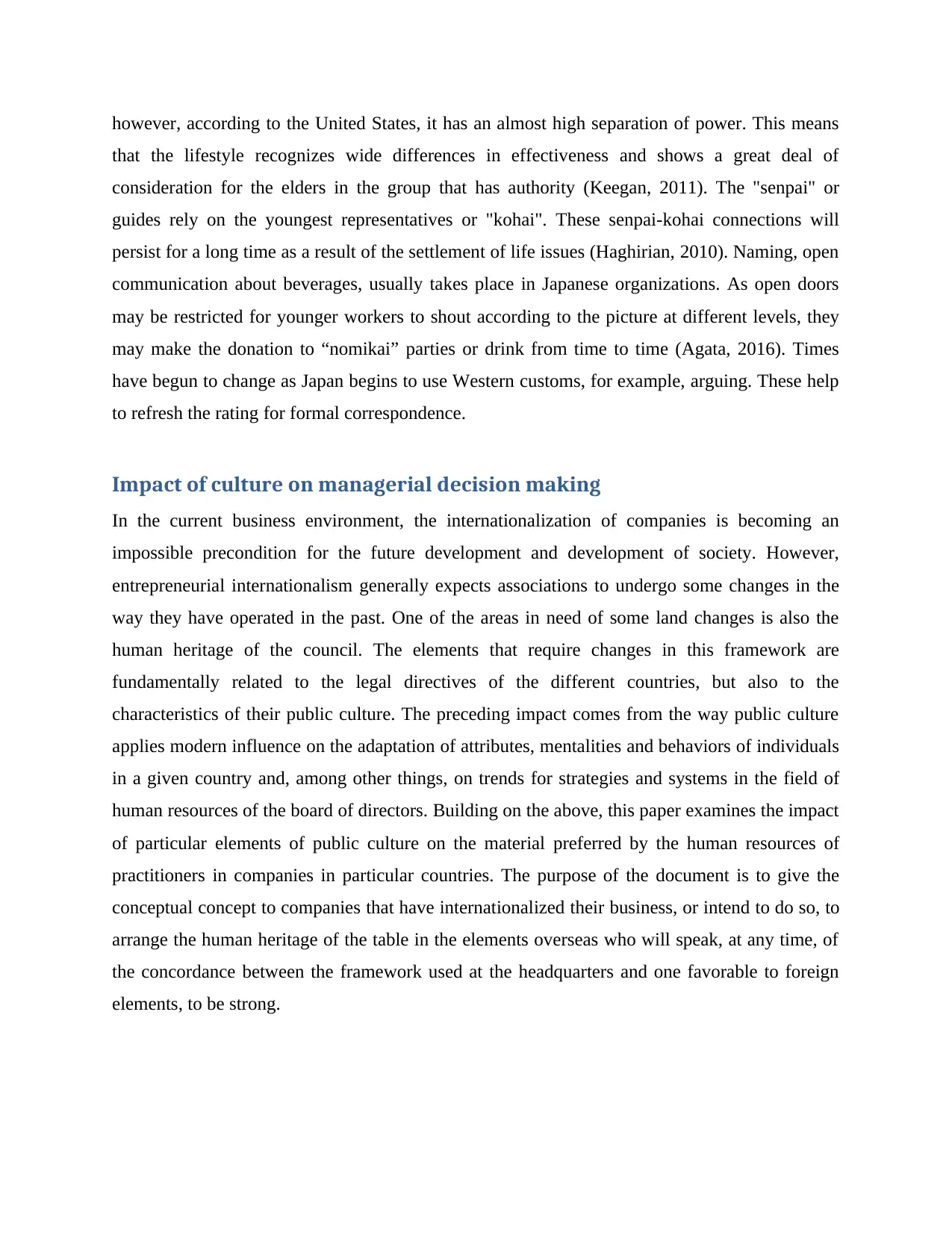
however, according to the United States, it has an almost high separation of power. This means
that the lifestyle recognizes wide differences in effectiveness and shows a great deal of
consideration for the elders in the group that has authority (Keegan, 2011). The "senpai" or
guides rely on the youngest representatives or "kohai". These senpai-kohai connections will
persist for a long time as a result of the settlement of life issues (Haghirian, 2010). Naming, open
communication about beverages, usually takes place in Japanese organizations. As open doors
may be restricted for younger workers to shout according to the picture at different levels, they
may make the donation to “nomikai” parties or drink from time to time (Agata, 2016). Times
have begun to change as Japan begins to use Western customs, for example, arguing. These help
to refresh the rating for formal correspondence.
Impact of culture on managerial decision making
In the current business environment, the internationalization of companies is becoming an
impossible precondition for the future development and development of society. However,
entrepreneurial internationalism generally expects associations to undergo some changes in the
way they have operated in the past. One of the areas in need of some land changes is also the
human heritage of the council. The elements that require changes in this framework are
fundamentally related to the legal directives of the different countries, but also to the
characteristics of their public culture. The preceding impact comes from the way public culture
applies modern influence on the adaptation of attributes, mentalities and behaviors of individuals
in a given country and, among other things, on trends for strategies and systems in the field of
human resources of the board of directors. Building on the above, this paper examines the impact
of particular elements of public culture on the material preferred by the human resources of
practitioners in companies in particular countries. The purpose of the document is to give the
conceptual concept to companies that have internationalized their business, or intend to do so, to
arrange the human heritage of the table in the elements overseas who will speak, at any time, of
the concordance between the framework used at the headquarters and one favorable to foreign
elements, to be strong.
that the lifestyle recognizes wide differences in effectiveness and shows a great deal of
consideration for the elders in the group that has authority (Keegan, 2011). The "senpai" or
guides rely on the youngest representatives or "kohai". These senpai-kohai connections will
persist for a long time as a result of the settlement of life issues (Haghirian, 2010). Naming, open
communication about beverages, usually takes place in Japanese organizations. As open doors
may be restricted for younger workers to shout according to the picture at different levels, they
may make the donation to “nomikai” parties or drink from time to time (Agata, 2016). Times
have begun to change as Japan begins to use Western customs, for example, arguing. These help
to refresh the rating for formal correspondence.
Impact of culture on managerial decision making
In the current business environment, the internationalization of companies is becoming an
impossible precondition for the future development and development of society. However,
entrepreneurial internationalism generally expects associations to undergo some changes in the
way they have operated in the past. One of the areas in need of some land changes is also the
human heritage of the council. The elements that require changes in this framework are
fundamentally related to the legal directives of the different countries, but also to the
characteristics of their public culture. The preceding impact comes from the way public culture
applies modern influence on the adaptation of attributes, mentalities and behaviors of individuals
in a given country and, among other things, on trends for strategies and systems in the field of
human resources of the board of directors. Building on the above, this paper examines the impact
of particular elements of public culture on the material preferred by the human resources of
practitioners in companies in particular countries. The purpose of the document is to give the
conceptual concept to companies that have internationalized their business, or intend to do so, to
arrange the human heritage of the table in the elements overseas who will speak, at any time, of
the concordance between the framework used at the headquarters and one favorable to foreign
elements, to be strong.
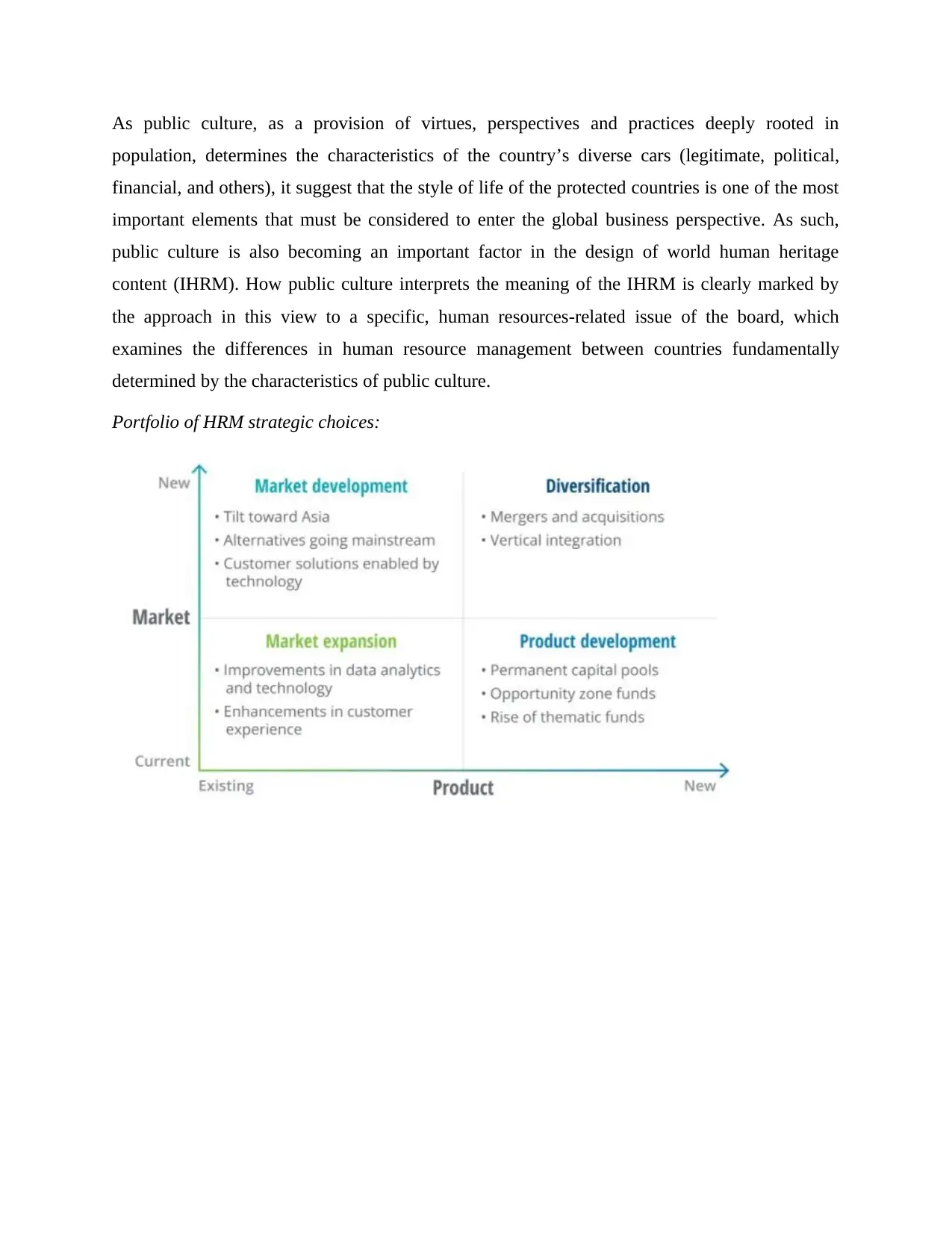
As public culture, as a provision of virtues, perspectives and practices deeply rooted in
population, determines the characteristics of the country’s diverse cars (legitimate, political,
financial, and others), it suggest that the style of life of the protected countries is one of the most
important elements that must be considered to enter the global business perspective. As such,
public culture is also becoming an important factor in the design of world human heritage
content (IHRM). How public culture interprets the meaning of the IHRM is clearly marked by
the approach in this view to a specific, human resources-related issue of the board, which
examines the differences in human resource management between countries fundamentally
determined by the characteristics of public culture.
Portfolio of HRM strategic choices:
population, determines the characteristics of the country’s diverse cars (legitimate, political,
financial, and others), it suggest that the style of life of the protected countries is one of the most
important elements that must be considered to enter the global business perspective. As such,
public culture is also becoming an important factor in the design of world human heritage
content (IHRM). How public culture interprets the meaning of the IHRM is clearly marked by
the approach in this view to a specific, human resources-related issue of the board, which
examines the differences in human resource management between countries fundamentally
determined by the characteristics of public culture.
Portfolio of HRM strategic choices:
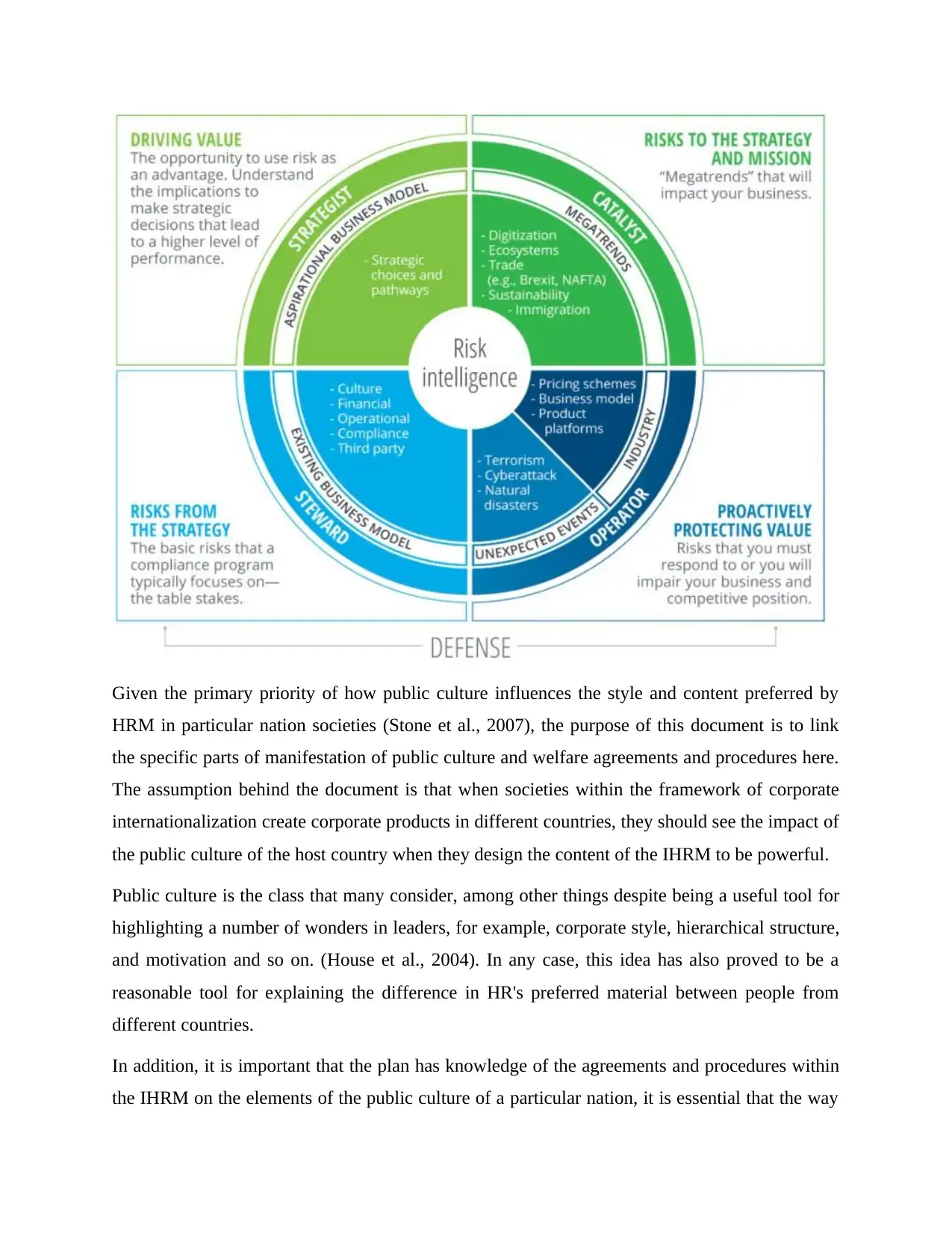
Given the primary priority of how public culture influences the style and content preferred by
HRM in particular nation societies (Stone et al., 2007), the purpose of this document is to link
the specific parts of manifestation of public culture and welfare agreements and procedures here.
The assumption behind the document is that when societies within the framework of corporate
internationalization create corporate products in different countries, they should see the impact of
the public culture of the host country when they design the content of the IHRM to be powerful.
Public culture is the class that many consider, among other things despite being a useful tool for
highlighting a number of wonders in leaders, for example, corporate style, hierarchical structure,
and motivation and so on. (House et al., 2004). In any case, this idea has also proved to be a
reasonable tool for explaining the difference in HR's preferred material between people from
different countries.
In addition, it is important that the plan has knowledge of the agreements and procedures within
the IHRM on the elements of the public culture of a particular nation, it is essential that the way
HRM in particular nation societies (Stone et al., 2007), the purpose of this document is to link
the specific parts of manifestation of public culture and welfare agreements and procedures here.
The assumption behind the document is that when societies within the framework of corporate
internationalization create corporate products in different countries, they should see the impact of
the public culture of the host country when they design the content of the IHRM to be powerful.
Public culture is the class that many consider, among other things despite being a useful tool for
highlighting a number of wonders in leaders, for example, corporate style, hierarchical structure,
and motivation and so on. (House et al., 2004). In any case, this idea has also proved to be a
reasonable tool for explaining the difference in HR's preferred material between people from
different countries.
In addition, it is important that the plan has knowledge of the agreements and procedures within
the IHRM on the elements of the public culture of a particular nation, it is essential that the way
Paraphrase This Document
Need a fresh take? Get an instant paraphrase of this document with our AI Paraphraser
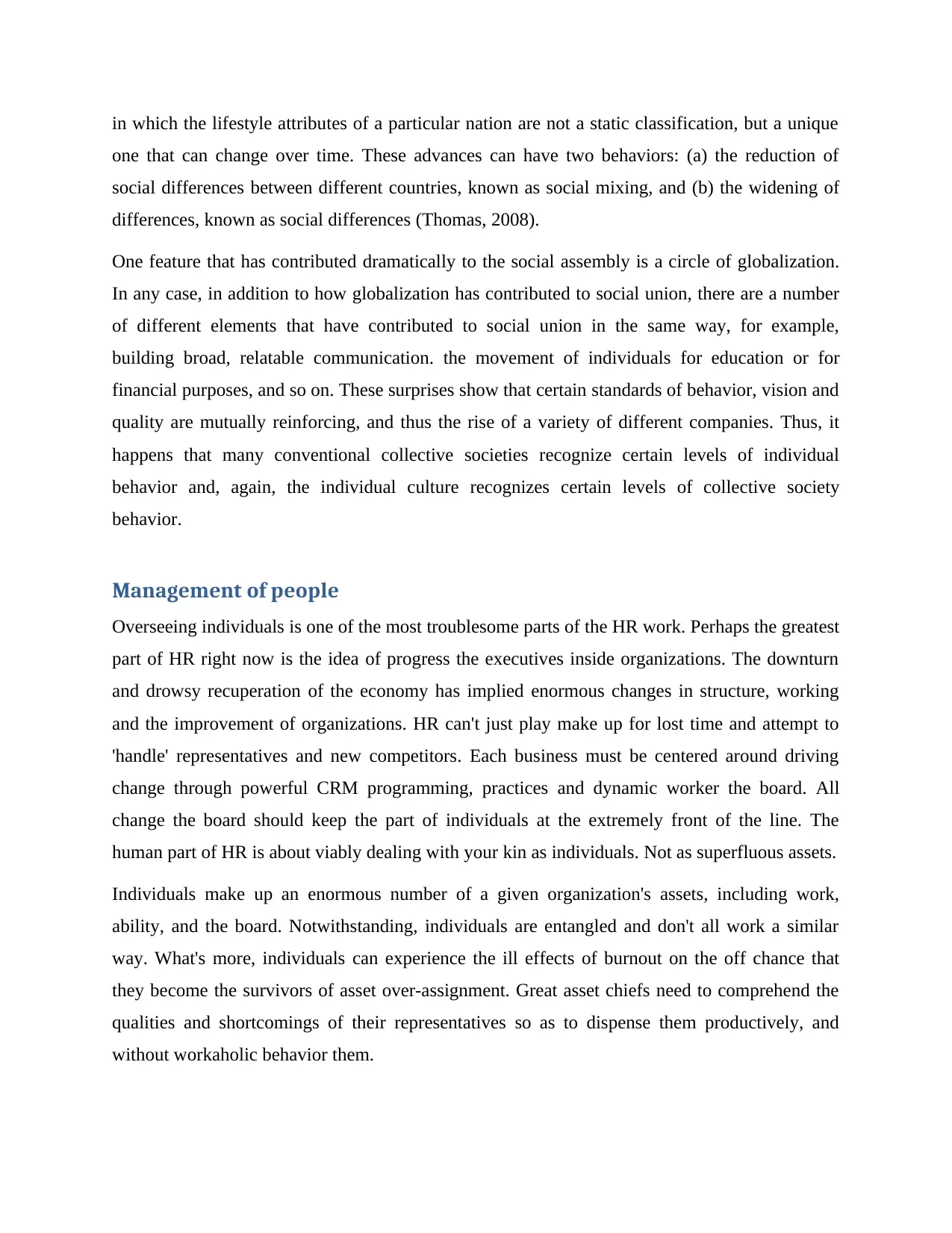
in which the lifestyle attributes of a particular nation are not a static classification, but a unique
one that can change over time. These advances can have two behaviors: (a) the reduction of
social differences between different countries, known as social mixing, and (b) the widening of
differences, known as social differences (Thomas, 2008).
One feature that has contributed dramatically to the social assembly is a circle of globalization.
In any case, in addition to how globalization has contributed to social union, there are a number
of different elements that have contributed to social union in the same way, for example,
building broad, relatable communication. the movement of individuals for education or for
financial purposes, and so on. These surprises show that certain standards of behavior, vision and
quality are mutually reinforcing, and thus the rise of a variety of different companies. Thus, it
happens that many conventional collective societies recognize certain levels of individual
behavior and, again, the individual culture recognizes certain levels of collective society
behavior.
Management of people
Overseeing individuals is one of the most troublesome parts of the HR work. Perhaps the greatest
part of HR right now is the idea of progress the executives inside organizations. The downturn
and drowsy recuperation of the economy has implied enormous changes in structure, working
and the improvement of organizations. HR can't just play make up for lost time and attempt to
'handle' representatives and new competitors. Each business must be centered around driving
change through powerful CRM programming, practices and dynamic worker the board. All
change the board should keep the part of individuals at the extremely front of the line. The
human part of HR is about viably dealing with your kin as individuals. Not as superfluous assets.
Individuals make up an enormous number of a given organization's assets, including work,
ability, and the board. Notwithstanding, individuals are entangled and don't all work a similar
way. What's more, individuals can experience the ill effects of burnout on the off chance that
they become the survivors of asset over-assignment. Great asset chiefs need to comprehend the
qualities and shortcomings of their representatives so as to dispense them productively, and
without workaholic behavior them.
one that can change over time. These advances can have two behaviors: (a) the reduction of
social differences between different countries, known as social mixing, and (b) the widening of
differences, known as social differences (Thomas, 2008).
One feature that has contributed dramatically to the social assembly is a circle of globalization.
In any case, in addition to how globalization has contributed to social union, there are a number
of different elements that have contributed to social union in the same way, for example,
building broad, relatable communication. the movement of individuals for education or for
financial purposes, and so on. These surprises show that certain standards of behavior, vision and
quality are mutually reinforcing, and thus the rise of a variety of different companies. Thus, it
happens that many conventional collective societies recognize certain levels of individual
behavior and, again, the individual culture recognizes certain levels of collective society
behavior.
Management of people
Overseeing individuals is one of the most troublesome parts of the HR work. Perhaps the greatest
part of HR right now is the idea of progress the executives inside organizations. The downturn
and drowsy recuperation of the economy has implied enormous changes in structure, working
and the improvement of organizations. HR can't just play make up for lost time and attempt to
'handle' representatives and new competitors. Each business must be centered around driving
change through powerful CRM programming, practices and dynamic worker the board. All
change the board should keep the part of individuals at the extremely front of the line. The
human part of HR is about viably dealing with your kin as individuals. Not as superfluous assets.
Individuals make up an enormous number of a given organization's assets, including work,
ability, and the board. Notwithstanding, individuals are entangled and don't all work a similar
way. What's more, individuals can experience the ill effects of burnout on the off chance that
they become the survivors of asset over-assignment. Great asset chiefs need to comprehend the
qualities and shortcomings of their representatives so as to dispense them productively, and
without workaholic behavior them.
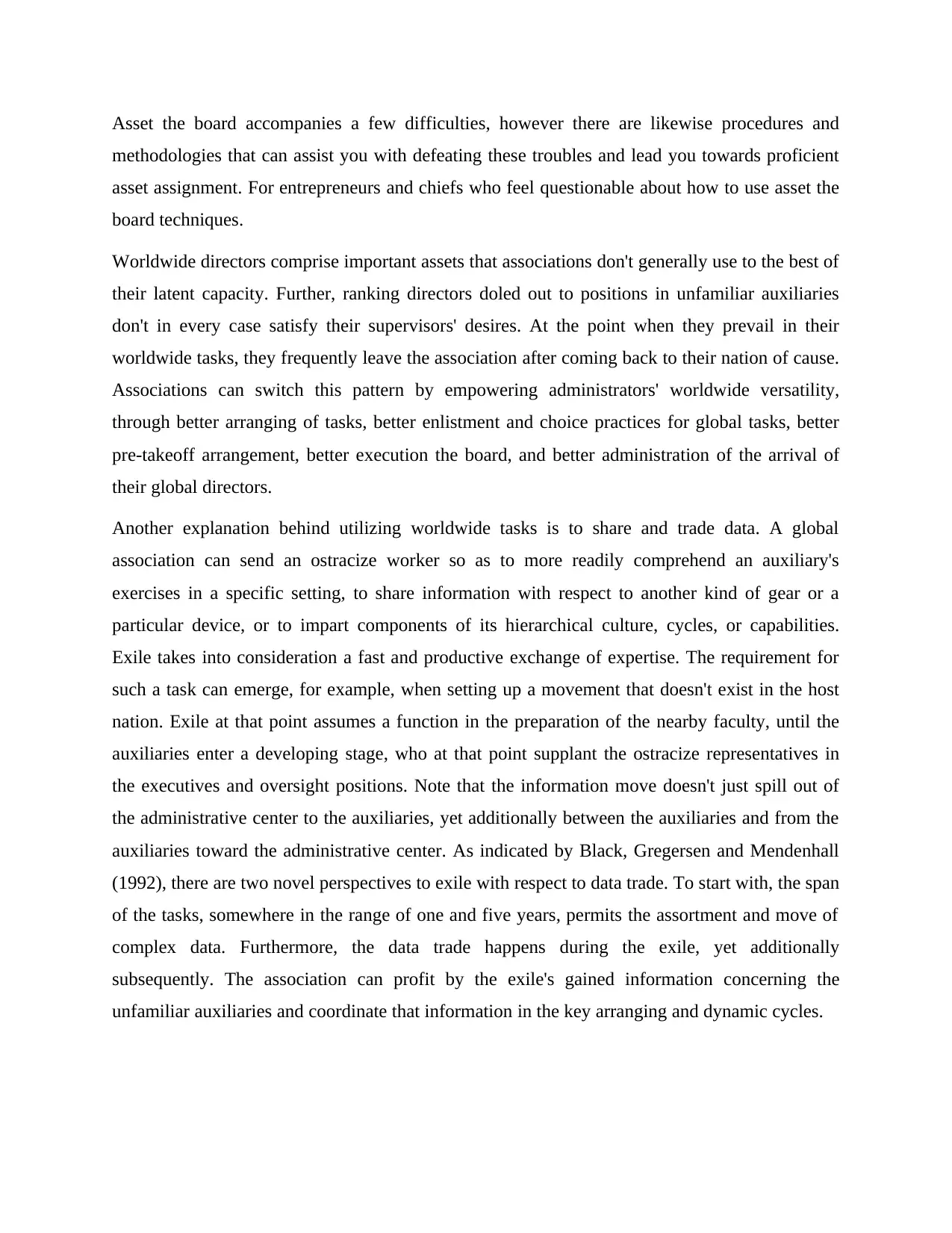
Asset the board accompanies a few difficulties, however there are likewise procedures and
methodologies that can assist you with defeating these troubles and lead you towards proficient
asset assignment. For entrepreneurs and chiefs who feel questionable about how to use asset the
board techniques.
Worldwide directors comprise important assets that associations don't generally use to the best of
their latent capacity. Further, ranking directors doled out to positions in unfamiliar auxiliaries
don't in every case satisfy their supervisors' desires. At the point when they prevail in their
worldwide tasks, they frequently leave the association after coming back to their nation of cause.
Associations can switch this pattern by empowering administrators' worldwide versatility,
through better arranging of tasks, better enlistment and choice practices for global tasks, better
pre-takeoff arrangement, better execution the board, and better administration of the arrival of
their global directors.
Another explanation behind utilizing worldwide tasks is to share and trade data. A global
association can send an ostracize worker so as to more readily comprehend an auxiliary's
exercises in a specific setting, to share information with respect to another kind of gear or a
particular device, or to impart components of its hierarchical culture, cycles, or capabilities.
Exile takes into consideration a fast and productive exchange of expertise. The requirement for
such a task can emerge, for example, when setting up a movement that doesn't exist in the host
nation. Exile at that point assumes a function in the preparation of the nearby faculty, until the
auxiliaries enter a developing stage, who at that point supplant the ostracize representatives in
the executives and oversight positions. Note that the information move doesn't just spill out of
the administrative center to the auxiliaries, yet additionally between the auxiliaries and from the
auxiliaries toward the administrative center. As indicated by Black, Gregersen and Mendenhall
(1992), there are two novel perspectives to exile with respect to data trade. To start with, the span
of the tasks, somewhere in the range of one and five years, permits the assortment and move of
complex data. Furthermore, the data trade happens during the exile, yet additionally
subsequently. The association can profit by the exile's gained information concerning the
unfamiliar auxiliaries and coordinate that information in the key arranging and dynamic cycles.
methodologies that can assist you with defeating these troubles and lead you towards proficient
asset assignment. For entrepreneurs and chiefs who feel questionable about how to use asset the
board techniques.
Worldwide directors comprise important assets that associations don't generally use to the best of
their latent capacity. Further, ranking directors doled out to positions in unfamiliar auxiliaries
don't in every case satisfy their supervisors' desires. At the point when they prevail in their
worldwide tasks, they frequently leave the association after coming back to their nation of cause.
Associations can switch this pattern by empowering administrators' worldwide versatility,
through better arranging of tasks, better enlistment and choice practices for global tasks, better
pre-takeoff arrangement, better execution the board, and better administration of the arrival of
their global directors.
Another explanation behind utilizing worldwide tasks is to share and trade data. A global
association can send an ostracize worker so as to more readily comprehend an auxiliary's
exercises in a specific setting, to share information with respect to another kind of gear or a
particular device, or to impart components of its hierarchical culture, cycles, or capabilities.
Exile takes into consideration a fast and productive exchange of expertise. The requirement for
such a task can emerge, for example, when setting up a movement that doesn't exist in the host
nation. Exile at that point assumes a function in the preparation of the nearby faculty, until the
auxiliaries enter a developing stage, who at that point supplant the ostracize representatives in
the executives and oversight positions. Note that the information move doesn't just spill out of
the administrative center to the auxiliaries, yet additionally between the auxiliaries and from the
auxiliaries toward the administrative center. As indicated by Black, Gregersen and Mendenhall
(1992), there are two novel perspectives to exile with respect to data trade. To start with, the span
of the tasks, somewhere in the range of one and five years, permits the assortment and move of
complex data. Furthermore, the data trade happens during the exile, yet additionally
subsequently. The association can profit by the exile's gained information concerning the
unfamiliar auxiliaries and coordinate that information in the key arranging and dynamic cycles.
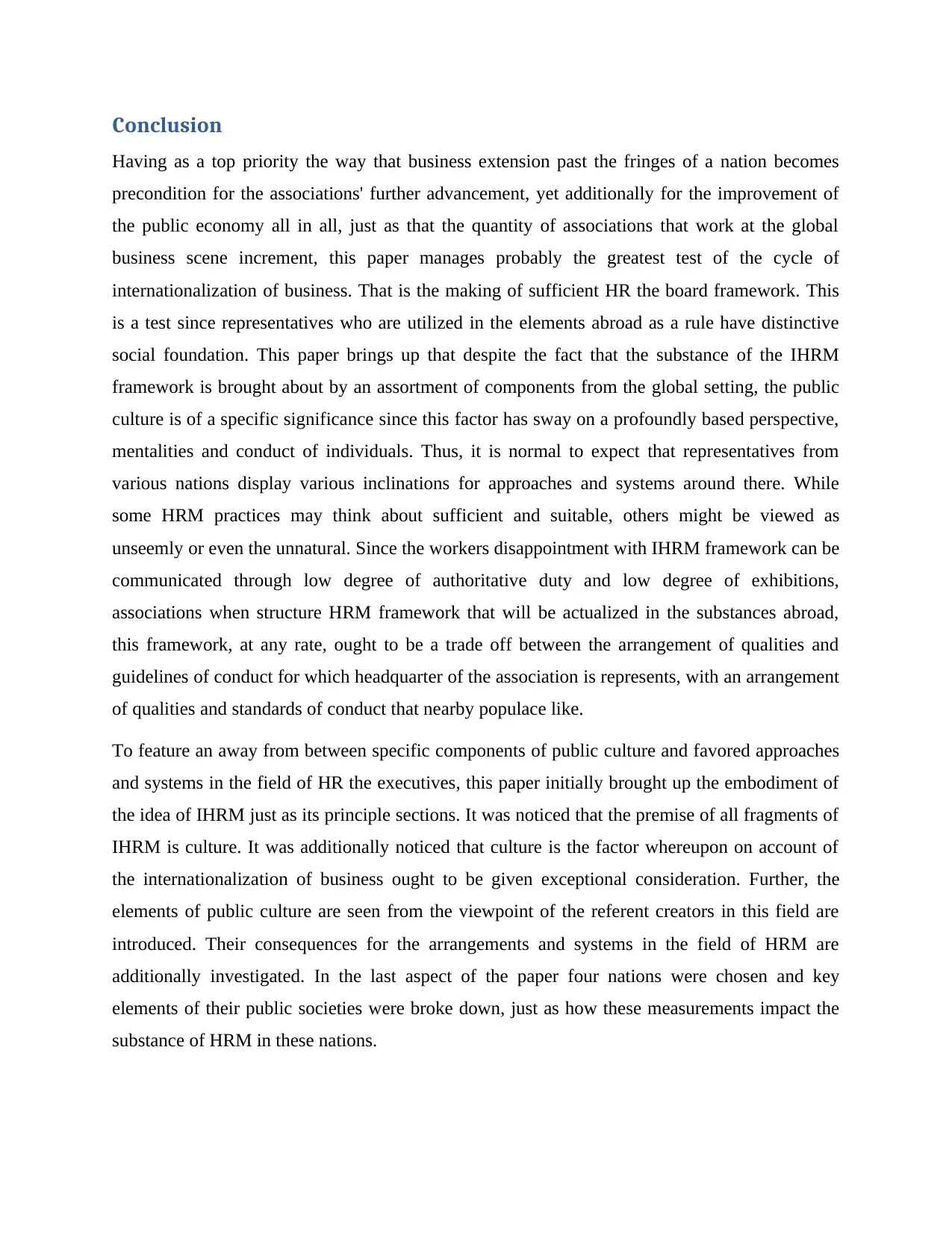
Conclusion
Having as a top priority the way that business extension past the fringes of a nation becomes
precondition for the associations' further advancement, yet additionally for the improvement of
the public economy all in all, just as that the quantity of associations that work at the global
business scene increment, this paper manages probably the greatest test of the cycle of
internationalization of business. That is the making of sufficient HR the board framework. This
is a test since representatives who are utilized in the elements abroad as a rule have distinctive
social foundation. This paper brings up that despite the fact that the substance of the IHRM
framework is brought about by an assortment of components from the global setting, the public
culture is of a specific significance since this factor has sway on a profoundly based perspective,
mentalities and conduct of individuals. Thus, it is normal to expect that representatives from
various nations display various inclinations for approaches and systems around there. While
some HRM practices may think about sufficient and suitable, others might be viewed as
unseemly or even the unnatural. Since the workers disappointment with IHRM framework can be
communicated through low degree of authoritative duty and low degree of exhibitions,
associations when structure HRM framework that will be actualized in the substances abroad,
this framework, at any rate, ought to be a trade off between the arrangement of qualities and
guidelines of conduct for which headquarter of the association is represents, with an arrangement
of qualities and standards of conduct that nearby populace like.
To feature an away from between specific components of public culture and favored approaches
and systems in the field of HR the executives, this paper initially brought up the embodiment of
the idea of IHRM just as its principle sections. It was noticed that the premise of all fragments of
IHRM is culture. It was additionally noticed that culture is the factor whereupon on account of
the internationalization of business ought to be given exceptional consideration. Further, the
elements of public culture are seen from the viewpoint of the referent creators in this field are
introduced. Their consequences for the arrangements and systems in the field of HRM are
additionally investigated. In the last aspect of the paper four nations were chosen and key
elements of their public societies were broke down, just as how these measurements impact the
substance of HRM in these nations.
Having as a top priority the way that business extension past the fringes of a nation becomes
precondition for the associations' further advancement, yet additionally for the improvement of
the public economy all in all, just as that the quantity of associations that work at the global
business scene increment, this paper manages probably the greatest test of the cycle of
internationalization of business. That is the making of sufficient HR the board framework. This
is a test since representatives who are utilized in the elements abroad as a rule have distinctive
social foundation. This paper brings up that despite the fact that the substance of the IHRM
framework is brought about by an assortment of components from the global setting, the public
culture is of a specific significance since this factor has sway on a profoundly based perspective,
mentalities and conduct of individuals. Thus, it is normal to expect that representatives from
various nations display various inclinations for approaches and systems around there. While
some HRM practices may think about sufficient and suitable, others might be viewed as
unseemly or even the unnatural. Since the workers disappointment with IHRM framework can be
communicated through low degree of authoritative duty and low degree of exhibitions,
associations when structure HRM framework that will be actualized in the substances abroad,
this framework, at any rate, ought to be a trade off between the arrangement of qualities and
guidelines of conduct for which headquarter of the association is represents, with an arrangement
of qualities and standards of conduct that nearby populace like.
To feature an away from between specific components of public culture and favored approaches
and systems in the field of HR the executives, this paper initially brought up the embodiment of
the idea of IHRM just as its principle sections. It was noticed that the premise of all fragments of
IHRM is culture. It was additionally noticed that culture is the factor whereupon on account of
the internationalization of business ought to be given exceptional consideration. Further, the
elements of public culture are seen from the viewpoint of the referent creators in this field are
introduced. Their consequences for the arrangements and systems in the field of HRM are
additionally investigated. In the last aspect of the paper four nations were chosen and key
elements of their public societies were broke down, just as how these measurements impact the
substance of HRM in these nations.
Secure Best Marks with AI Grader
Need help grading? Try our AI Grader for instant feedback on your assignments.
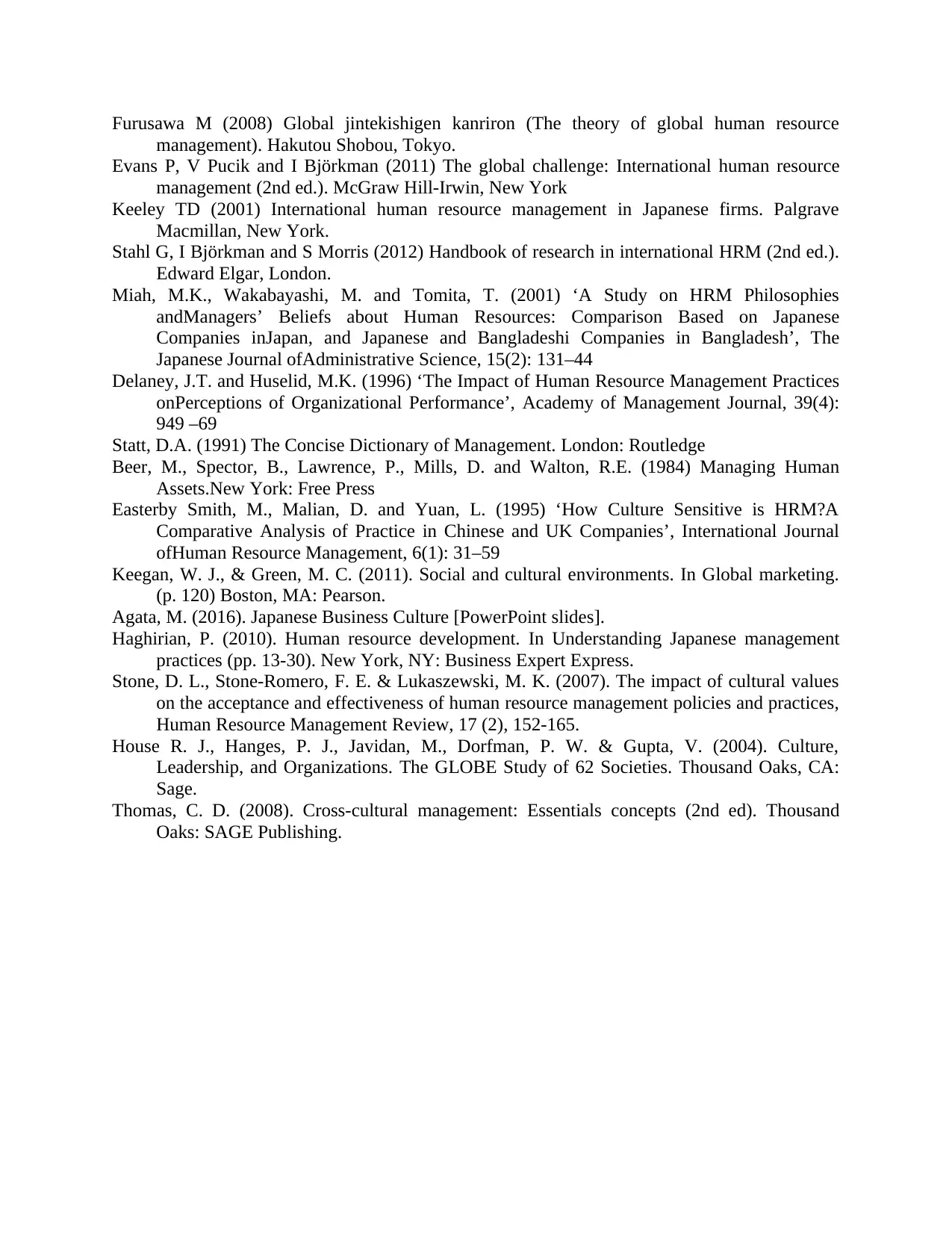
Furusawa M (2008) Global jintekishigen kanriron (The theory of global human resource
management). Hakutou Shobou, Tokyo.
Evans P, V Pucik and I Björkman (2011) The global challenge: International human resource
management (2nd ed.). McGraw Hill-Irwin, New York
Keeley TD (2001) International human resource management in Japanese firms. Palgrave
Macmillan, New York.
Stahl G, I Björkman and S Morris (2012) Handbook of research in international HRM (2nd ed.).
Edward Elgar, London.
Miah, M.K., Wakabayashi, M. and Tomita, T. (2001) ‘A Study on HRM Philosophies
andManagers’ Beliefs about Human Resources: Comparison Based on Japanese
Companies inJapan, and Japanese and Bangladeshi Companies in Bangladesh’, The
Japanese Journal ofAdministrative Science, 15(2): 131–44
Delaney, J.T. and Huselid, M.K. (1996) ‘The Impact of Human Resource Management Practices
onPerceptions of Organizational Performance’, Academy of Management Journal, 39(4):
949 –69
Statt, D.A. (1991) The Concise Dictionary of Management. London: Routledge
Beer, M., Spector, B., Lawrence, P., Mills, D. and Walton, R.E. (1984) Managing Human
Assets.New York: Free Press
Easterby Smith, M., Malian, D. and Yuan, L. (1995) ‘How Culture Sensitive is HRM?A
Comparative Analysis of Practice in Chinese and UK Companies’, International Journal
ofHuman Resource Management, 6(1): 31–59
Keegan, W. J., & Green, M. C. (2011). Social and cultural environments. In Global marketing.
(p. 120) Boston, MA: Pearson.
Agata, M. (2016). Japanese Business Culture [PowerPoint slides].
Haghirian, P. (2010). Human resource development. In Understanding Japanese management
practices (pp. 13-30). New York, NY: Business Expert Express.
Stone, D. L., Stone-Romero, F. E. & Lukaszewski, M. K. (2007). The impact of cultural values
on the acceptance and effectiveness of human resource management policies and practices,
Human Resource Management Review, 17 (2), 152-165.
House R. J., Hanges, P. J., Javidan, M., Dorfman, P. W. & Gupta, V. (2004). Culture,
Leadership, and Organizations. The GLOBE Study of 62 Societies. Thousand Oaks, CA:
Sage.
Thomas, C. D. (2008). Cross-cultural management: Essentials concepts (2nd ed). Thousand
Oaks: SAGE Publishing.
management). Hakutou Shobou, Tokyo.
Evans P, V Pucik and I Björkman (2011) The global challenge: International human resource
management (2nd ed.). McGraw Hill-Irwin, New York
Keeley TD (2001) International human resource management in Japanese firms. Palgrave
Macmillan, New York.
Stahl G, I Björkman and S Morris (2012) Handbook of research in international HRM (2nd ed.).
Edward Elgar, London.
Miah, M.K., Wakabayashi, M. and Tomita, T. (2001) ‘A Study on HRM Philosophies
andManagers’ Beliefs about Human Resources: Comparison Based on Japanese
Companies inJapan, and Japanese and Bangladeshi Companies in Bangladesh’, The
Japanese Journal ofAdministrative Science, 15(2): 131–44
Delaney, J.T. and Huselid, M.K. (1996) ‘The Impact of Human Resource Management Practices
onPerceptions of Organizational Performance’, Academy of Management Journal, 39(4):
949 –69
Statt, D.A. (1991) The Concise Dictionary of Management. London: Routledge
Beer, M., Spector, B., Lawrence, P., Mills, D. and Walton, R.E. (1984) Managing Human
Assets.New York: Free Press
Easterby Smith, M., Malian, D. and Yuan, L. (1995) ‘How Culture Sensitive is HRM?A
Comparative Analysis of Practice in Chinese and UK Companies’, International Journal
ofHuman Resource Management, 6(1): 31–59
Keegan, W. J., & Green, M. C. (2011). Social and cultural environments. In Global marketing.
(p. 120) Boston, MA: Pearson.
Agata, M. (2016). Japanese Business Culture [PowerPoint slides].
Haghirian, P. (2010). Human resource development. In Understanding Japanese management
practices (pp. 13-30). New York, NY: Business Expert Express.
Stone, D. L., Stone-Romero, F. E. & Lukaszewski, M. K. (2007). The impact of cultural values
on the acceptance and effectiveness of human resource management policies and practices,
Human Resource Management Review, 17 (2), 152-165.
House R. J., Hanges, P. J., Javidan, M., Dorfman, P. W. & Gupta, V. (2004). Culture,
Leadership, and Organizations. The GLOBE Study of 62 Societies. Thousand Oaks, CA:
Sage.
Thomas, C. D. (2008). Cross-cultural management: Essentials concepts (2nd ed). Thousand
Oaks: SAGE Publishing.
1 out of 11
Related Documents
Your All-in-One AI-Powered Toolkit for Academic Success.
+13062052269
info@desklib.com
Available 24*7 on WhatsApp / Email
![[object Object]](/_next/static/media/star-bottom.7253800d.svg)
Unlock your academic potential
© 2024 | Zucol Services PVT LTD | All rights reserved.





